|
12. Pyrgus malvae (Linnaeus 1758) / Grizzled skipper / Hesperiidae – Pyrginae
NL: aardbeidikkopje, aarbeivlinder / D: Malven-Dickkopffalter, Kleiner Würfel-Dickkopffalter, Gewönlicher Würfeldickkopf / F: hespérie de la mauve, tacheté
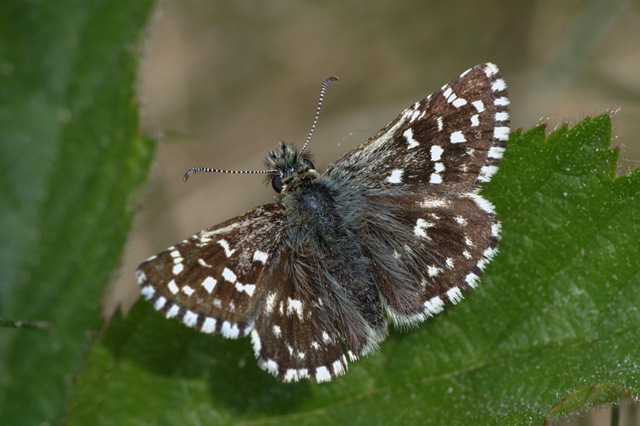 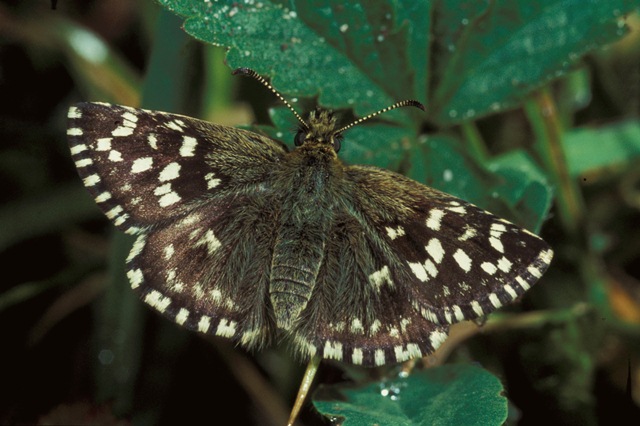 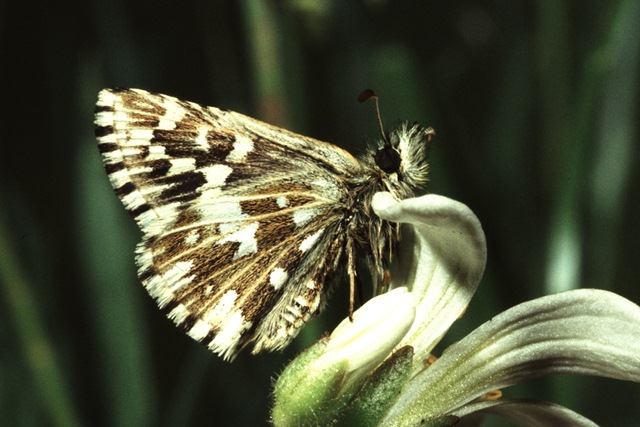
Photographs: Jeroen Voogd, Frits Bink, Frits Bink ©.
Very small, wing length 11 (10-12) mm. The species occurs in various landscapes: dunes, heathland, bogs, marshes, grassland, scrubland, woodland. In the Benelux it is widely spread but local.
Butterfly is on the wing from end-April until mid-July and peaks end-May and occurs in maritime and severe continental climates, amplitude 6 to 20, required heat sum 550°d and maximum tolerated 1800°d. This corresponds with climate windows of 20 weeks and 35 weeks.
It occurs usually in gradients from wood or shrubland to short grassland with patches of bare soil.
Populations survive also in hayfields which are mown only once a year late in the season.
Ecological characteristics
Behaviour over time
Overwintering: pupa hidden in the litter.
Reproduction: oviposition starts after 5-6 days when the body contains 38 (30-43) eggs. Estimated potential production 1.7 times as much.
Larval feeding periods: 9 weeks in the period end-May until mid-August.
Generations: one.
Spreading of risk: variation in appearance of the adults of about one month. A few of the overwintering pupae will enter diapause for a second winter and hatch a year later.
Life cycle: egg 9 (5-14) days; larva 62 (56-68) days; pupa 40-47 weeks or 95 weeks in the case of a second overwintering.
Life span of adult: short, 2 weeks.
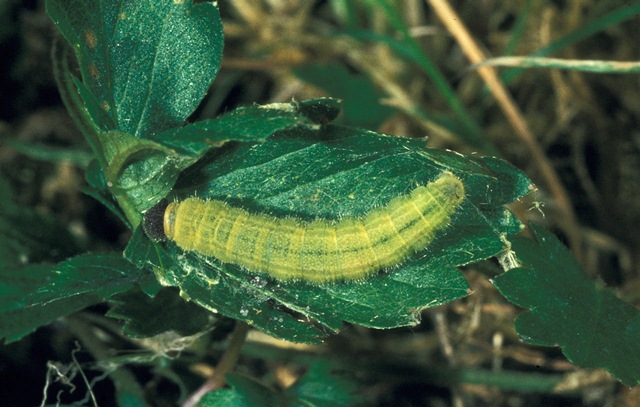 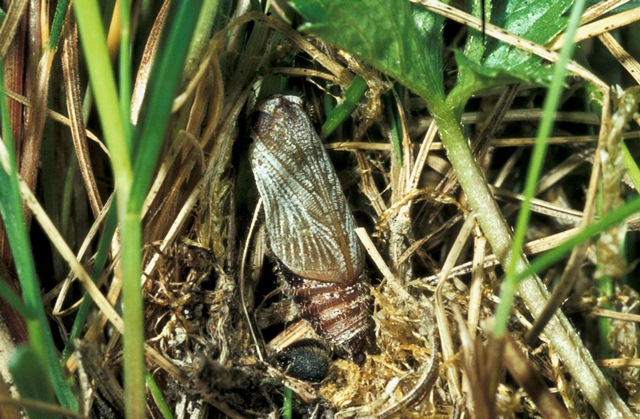
Photographs: Frits Bink ©.
Behaviour in space
From stay-at-home to migrant: stay-at-home type, spatial requirement modest.
Finding a mate: males perch but sometimes join with females on flowering herbs.
Orientation in the landscape: in general the adults select boundaries in the landscape such as path verges, fringes woods. In heathland or grassland between short and tall vegetation.
Oviposition: eggs are laid on underside of the leaf of the host plant. In the case of European dewberry (Rubus caesius) only dwarf plants are selected.
Defence
Threats from other organisms: larva lives hidden in folded leaves.
Threats from the environment: field observations have shown that the butterflies are rather susceptible to adverse weather.
Feeding habits
Adult: nectar, all kinds of flowers, e.g. bugle, bramble, ground ivy, thyme, cinquefoil.
Larva: feeds on the mature leaves and hides itself in the shelter of folded ones.
Larval foodplants
Plant species: Rosaceae, Fragaria moschata, F. vesca, Potentilla anglica, P. argentea, P. erecta, P. palustris, P. reptans, P. verna, Rubus caesius.
Journal
Rearing experiment based on specimen from the national park Hoge Veluwe, Netherlands:
1 June 1984: 1 female collected.
3 June: 18 eggs laid. Eggs remaining in the body: 25.
16 June: eggs hatched.
20 July: larvae in L3, 8 mm in length.
7 August: most of the larvae in L4, 10 mm in length.
12 August: biggest larvae nearly full grown and green in colour.
17 August: first pupa.
10 September: three pupae discovered.
Overwintered outdoors.
1 May 1985: first adult appeared, male.
4 May: second one, female, egg load 48 small immature eggs.
7-27 May: four adults appeared.
13 June: two unhatched pupae found, appearing to be healthy.
27 June: no further emergences, thus a partial second diapause is possible.
Table 12-1. Results of dissections

Table 12-2. Collection and observation localities
B, Nîsmes, Tiènne-Breumont 215 m, 50° 04’ 40”N – 4° 32’ 35”E; 28 May 1982.
B, Ethe, 240 m, 49° 36’ 25”N – 5° 35’ 50”E; 19 June 1983, 11 July 1984.
D, Blankenheim 50° 22’ 40”N – 6° 41’ 05”E; 20 June 1983.
D, Kaub 50° 05’ 36”N – 7° 45’ 43”E; 26 May 1986.
D, Lorch 300m, 50° 02’ 05”N – 7° 47’ 56”E; 26 May 1986.
F, Vosges, Bollenberg 363 m, 47° 56’ 54”N – 7° 15’21”E; 25 July 1983, 11 June 1984.
F, Vosges, Katzenkoepfle, 565m, 48° 01’ 54”N – 7° 06’ 04”E; 11 June 1984.
NL, Hoge Veluwe 52° 04’N – 5° 53’E; 15 June 1983, 1 June 1984, 22 April 2014.
NL, Hoge Veluwe 52° 05’N – 5° 51’E; 11 July 1983, 30 July 1984.
NL, Hoge Veluwe 52° 04’ 47”N – 5° 49’ 47”E; 27 July 2000.
NL, Hoge Veluwe 52° 03’ 41”N – 5° 50’ 46”E; 31 May 2002.
NL, Zegveld 52° 08’ 09”N – 4° 48’ 56”E; 28 June 1954, 10 June 1956, 28 June 1959, 11 June 1975, 16 June 1986.
S, Gotland, Folhammar 57° 20’ 49”N – 18° 44’ 12”E; 19 June 2004.
S, Gotland, Klinteklinten 57° 40’ 14”N – 18° 46’ 26”E; 13 July 2004.
Fig. 12-1. Pyrgus malvae, phenogram adapted from Fichefet et al. 2008: 51.
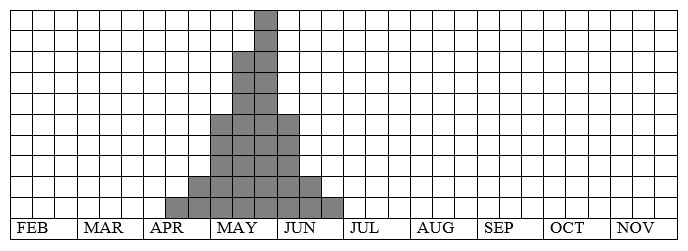
Fig. 12-2. Pyrgus malvae, habitat characteristics.
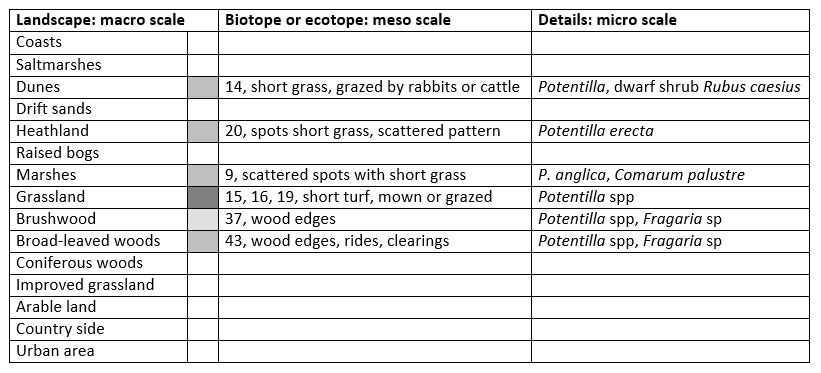
Fig. 12-3. Pyrgus malvae, climate matrix, heat-sums 550 - 1800°d.
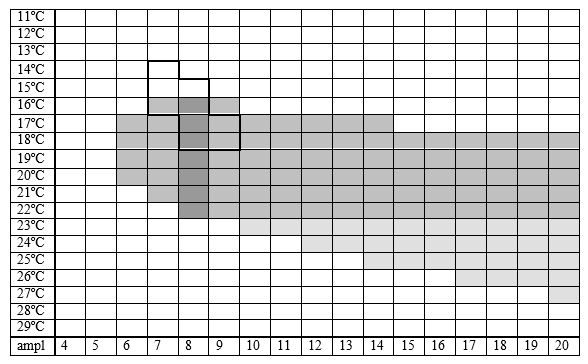
|










